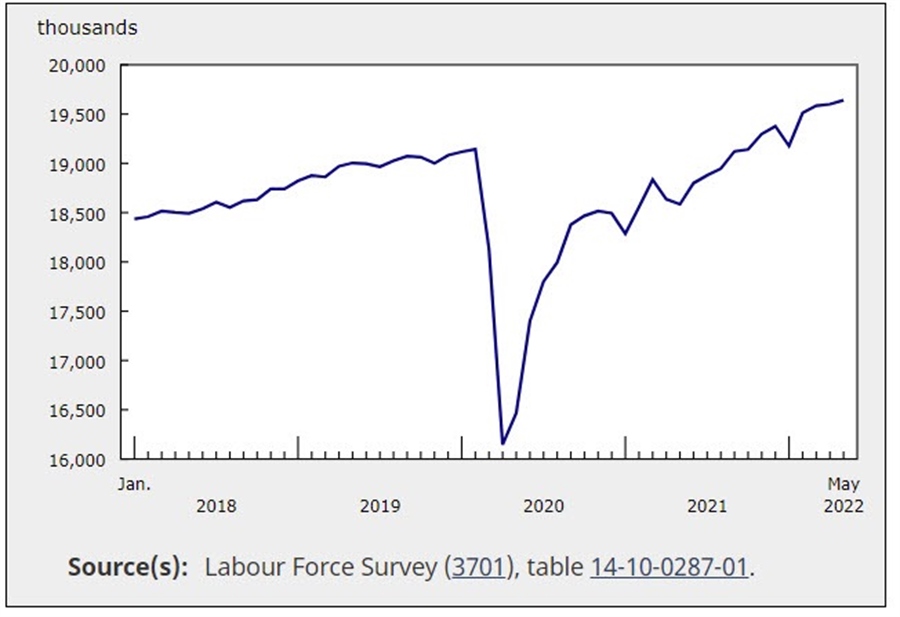- Prior report +15.3 K (that was lower than 55.0K estimate)
- Employment change 39.8K vs 30K estimate
- unemployment rate 5.1%% vs. 5.2% estimate. The unemployment rate is a new record
- full-time employment 135.4K vs. -31.6 K last month
- Part time employment -95.8K vs 47.1 K last month
- participation rate 65.3% vs 65.3% last month
- total hours worked were little change in May but up 5.1% compared with 12 months earlier
- average hourly earnings increased 3.9% on the year on year basis
- service producing jobs rose by 81,000. Goods producing jobs decreased by 41,000 mostly dudes decline in manufacturing (-43,000)
- The adjusted unemployment rate – which includes those who wanted a job but did not look for one – fell -0.2% to 7% in May. This was the lowest rate on record (going back to 1976)
- long-term unemployment account for 19.7% of all unemployed in May up from 15.6% in February 2020
The employment increase was driven by gains in full-time work which was spread across several industries led by wholesale and retail trade. Employment gains were driven by increases for women in each of the 3 main age groups categories (25 to 54 rose by +63K). Employment for men was little changed.
Employment in the services-producing sector rose by 81,000 (+0.5%) in May, with gains spread across several industries.
- accommodation and food services (+20,000; +1.9%) for a second consecutive month, consistent with increases in both GDP in the industry (+10.9%) and food services sales (+6.5%) in March.
- The number of people working in professional, scientific and technical services grew by 21,000 (+1.2%) in May, adding to the increase of 15,000 (+0.9%) seen in April, and bringing gains over the first five months of 2022 to 68,000 (+4.0%). A notable proportion of the increase in May in this industry occurred in Alberta (+11,000; +5.5%).
- educational services (+24,000; +1.6%)
- Retail trade (+34,000; +1.5%) in May,
- transportation and warehousing (-25,000; -2.4%)
- finance, insurance, real estate, rental and leasing (-19,000; -1.4%)
Overall employment in the goods-producing sector declined by 41,000 (-1.0%) in May
- Employment in manufacturing fell by 43,000 (-2.4%) in May, erasing gains seen during the fall of 2021 and returning employment in the industry to a level on par with May 2021. Monthly decreases were seen in six provinces, with the largest recorded in British Columbia (-11,000; -5.8%), Ontario (-16,000; -2.0%) and Quebec (-7,700; -1.5%).
- Employment held steady in construction in May, after falling in April. Employment in the industry had been trending upward from November 2021 to March 2022, and was up 5.3% on a year-over-year basis in May.
- There were 8,300 (+2.5%) more people working in natural resources in May, the third increase in five months. Gains in May were led by Quebec (+2,100; +4.3%).
Solid report for the jobs in May that keeps the BOC tightening.
The USDCAD moved higher initially but has moved back lower, but that is largely a reflection of the stronger CPI in the US.
For the full report CLICK HERE
This article was originally published by Forexlive.com. Read the original article here.
